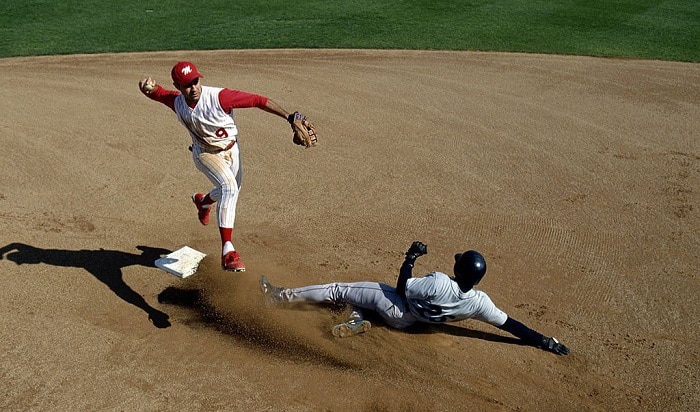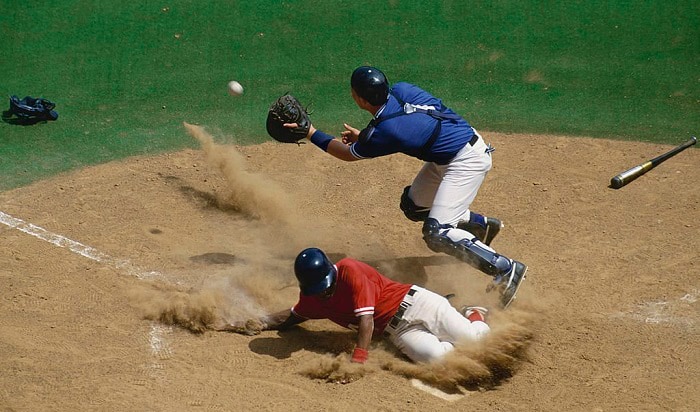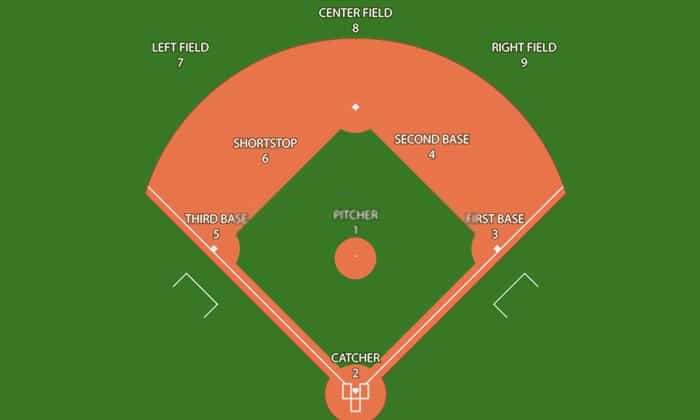Different scenarios in baseball can put out more than one player in a single hit. These are called double plays, the most common of which is a ground into double play.
So, exactly, what is ground into double play in baseball? It is a batting scenario that creates multiple outs. For instance, this happens when a batter hits a ground ball with a runner on any of the bases. In most cases, the runner is on first base.
Contents
What Does GIDP Mean in Baseball?
GIDP is simply an acronym for “Ground Into Double Play.” Sports writers, commentators, and baseball analysts often use this shortcut to refer to any ground ball that results in a double play during a game.
GIDP is among the standard stats reflected in baseball stat sheets. To understand the GIDP baseball stat better, let us look beyond just what the letters stand for and provide a clear definition for each.
G stands for the ground and indicates that that ball batted is a ground ball.
- A ground ball, also often referred to as a grounder, is a ball hit towards the ground in fair territory. A ground ball will either bounce or roll in the direction of the outfield.
- Ground balls result when the ball is hit with a downward swing, unlike line drives that are batted along a relatively straight line or fly balls with an upper trajectory.
Now, let’s move on to the DP baseball meaning. DP stands for double play and refers to any scenario wherein two outs result from the same play.
- Double plays can be achieved in various ways, but the most common among them is a ground ball hit with a runner on first base.
- In this scenario, the fielder who catches the ball will usually throw it to second base, after which the fielder on second will throw the ball to first base. This results in both the batter and the base runner being put out.
- While often viewed as a negative stat from the offensive end, double plays are a good indication of defensive as well as pitching prowess. Double plays are often referred to as a “pitcher’s best friend” because they can put out multiple players in a single pitch.
When Can a GIDP Occur in Baseball?
As mentioned earlier, the most common scenario for a GIDP is when a batter hits a ground ball with a runner on first base. However, a GIDP can also result when a runner or runners are on second or third base.
For instance, a runner on second or third base may try to steal a base when a batter hits a ground ball. Fielders may opt to tag the runner first, then throw the ball to first base or vice-versa.
A GIDP can also occur with all bases loaded. In this instance, the fielder will usually throw the ball to the catcher to force out the runner coming in from third. The ball is then fielded to first base to put the batter out.
Why Are Double Plays in Baseball Indicated in Numbers?
Double play baseball numbers make it easy for everyone to know the story behind each play. If you’ve been watching baseball for some time now, you’ll know that each defensive player is assigned a particular number.
For the benefit of those who aren’t familiar yet with the numbering system in baseball, here are the numbers assigned to each position:
The numbers representing a double play simply indicate who among the fielders participated in that particular play.
Furthermore, the order in which the numbers appear depicts the succession of the events that resulted in the double play.
To cite an example, a 6-4-3 double play is among the most common types of GIDPs in baseball. This usually happens when there is a runner on 1st base.
- In this scenario, the shortstop fields the ground ball and throws it to the 2nd baseman, who then throws it to the 1st baseman.
- As you can see, the numbers represent each player involved: 6 for the shortstop, 4 for the 2nd baseman, and 3 for the 1st baseman.
- The order in which the numbers appear tells you who got the ball first and how it was thrown around to achieve the multiple outs.
What Are Other Types of Ground Into Double Play?
While a 6-4-3 is the most common type of GIDP you’ll see in amateur baseball and the MLB, there are other scenarios that can result in a ground ball in double play.
1. 4-6-3 Double Play
With a runner on 1st base, a 4-6-3 double play scenario will have a center ground ball fielded by the 2nd baseman (4) who throws it to the shortstop (6) covering 2nd base. The shortstop then throws the ball to the 1st baseman (3) to retire the batter.
2. 5-4-3 Double Play
With a runner on 1st base, a 5-4-3 double play usually involves a ground ball hit towards the left side of fair territory. The 3rd baseman (5) fields the ball and throws it to the 2nd baseman (4) to put out the runner. Then, the 2nd baseman throws it to the 1st baseman (3) to put out the batter.
3. 3-6-1 Double Play
With a runner on 1st base, a 3-6-1 double play in baseball will typically have the 1st baseman (3) field a ground ball hit to the right side of fair territory.
He then throws it to the shortstop (6) covering 2nd base for the first out. The shortstop throws the ball to the pitcher (1) covering 1st base for the second out.
4. 3-6-4 Double Play
With a runner on 1st base, a 3-6-4 double play usually arises from a bunt fielded by the 1st baseman (3) to the shortstop (6) who is covering 2nd base to put out the base runner. The shortstop then throws the ball to the 2nd baseman (4) covering 1st base to retire the batter.
A 6-4-3, 4-6-3, and 5-4-3 are more common types of GIDPs in baseball. A 3-6-1 or a 3-6-4 occur quite rarely. There are other GIDPs that can happen and everything really depends on which player is nearest the bases at stake.
Conclusion
GIDPs add so much excitement to every baseball game. Ecstatic players dart across the field in elation and the entire stadium breaks into loud cheers every time a ground into double play is achieved.
Understanding different playing scenarios can make things more fun and interesting when you watch baseball. We hope this article has given you a thorough explanation and sufficient examples for your question, “what is ground into double play in baseball?”

A powerful swing and the ball is flying across the field, just one hit, and we might never forget the thrill it brings. I do not know about you, but I never do. Every baseball game is the chance to compete with others and cooperate with your teammate. It is among my biggest passions.
















